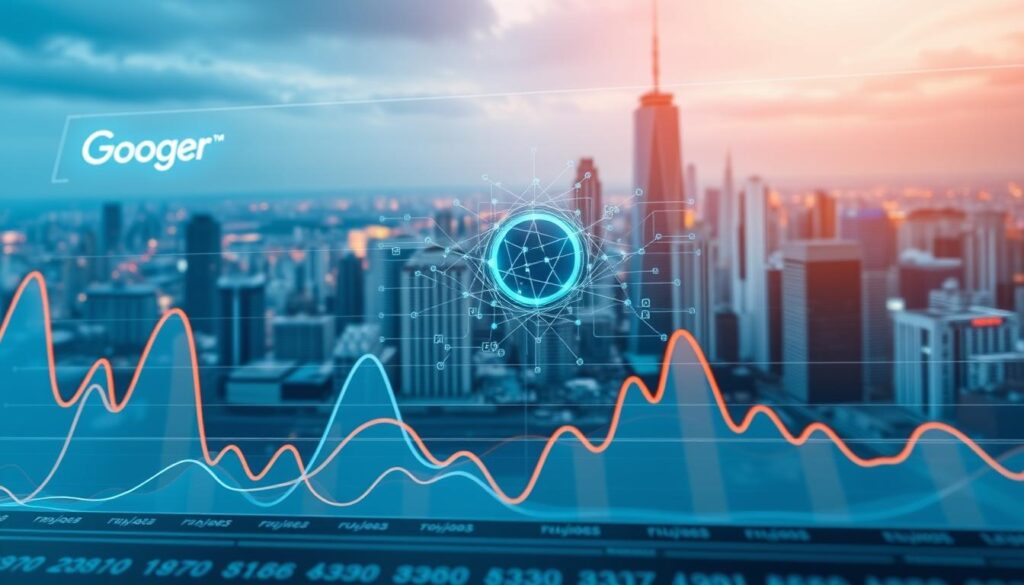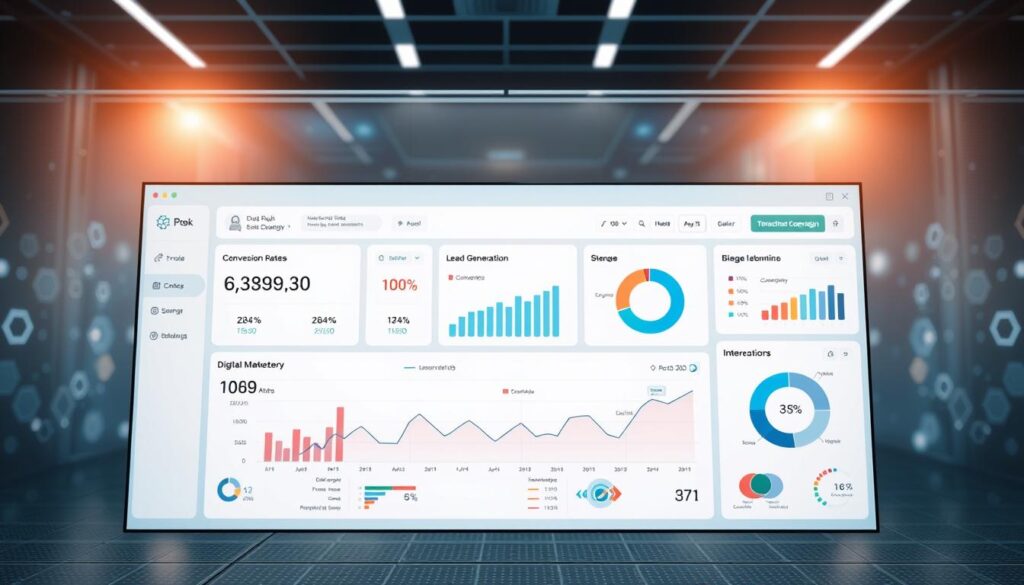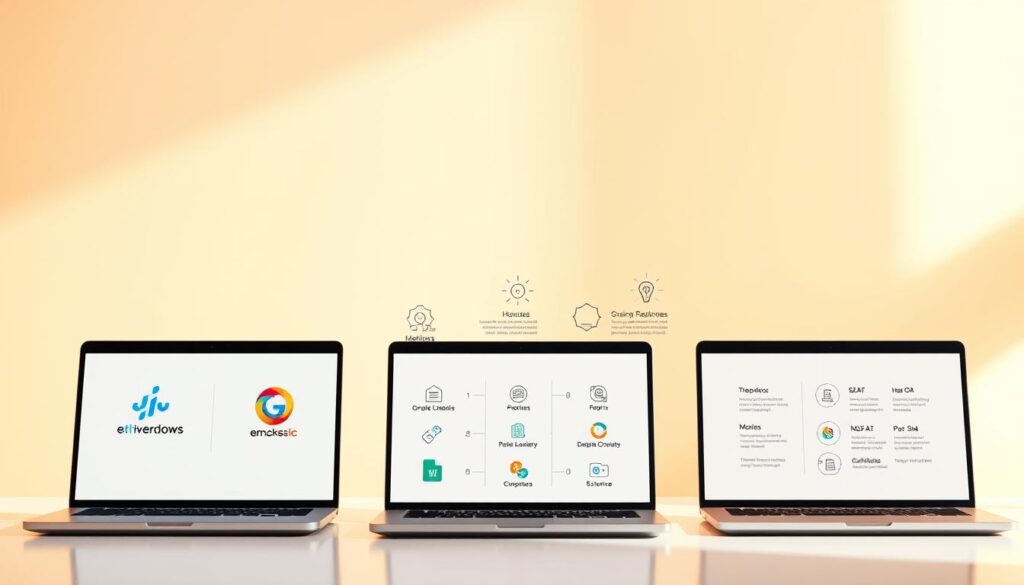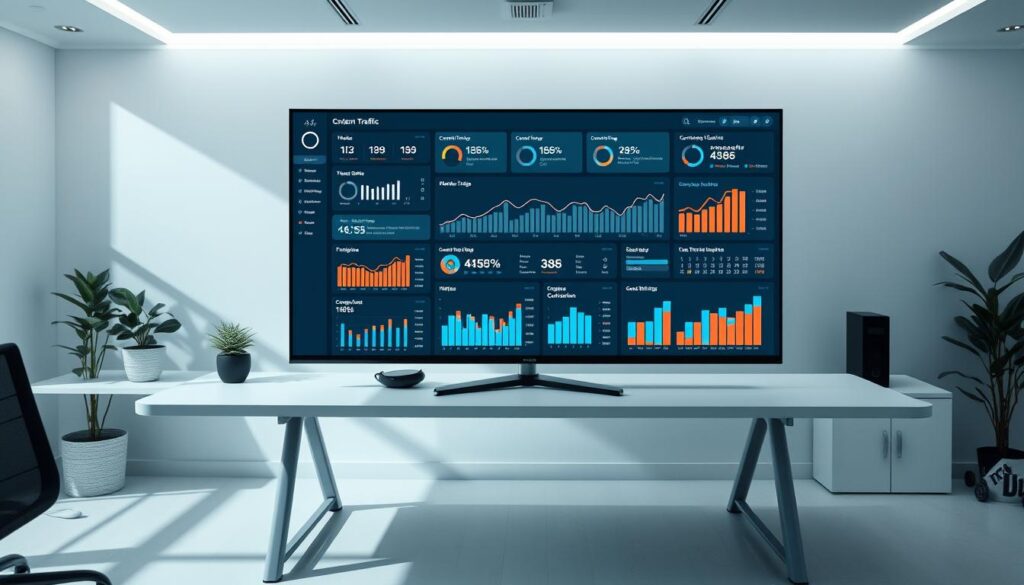The digital marketing landscape has undergone a seismic shift since 2019, driven by the integration of artificial intelligence into search engine optimization practices. Modern platforms now process vast datasets in real time, identifying trends invisible to manual analysis. Industry data reveals that 49.1% of global professionals anticipate improved website traffic through these innovations by 2028.
These advanced systems democratize enterprise-grade capabilities, enabling smaller businesses to compete in search rankings. By automating repetitive tasks like keyword tracking and performance reporting, teams redirect efforts toward strategic improvements. For example, AI-driven solutions in marketing now generate actionable insights for content optimization, reducing guesswork in campaign planning.
The transition from human-centric workflows to machine-assisted processes has redefined efficiency standards. Real-time adjustments based on predictive algorithms allow marketers to stay ahead of search engine updates, while data-backed recommendations enhance decision-making precision. This evolution underscores a critical advantage: scalable strategies that adapt as digital ecosystems evolve.
Key Takeaways
- Artificial intelligence has revolutionized how marketers analyze search performance and user behavior
- Real-time data processing enables faster identification of ranking opportunities
- Small businesses now access capabilities previously limited to large enterprises
- Automation reduces time spent on routine tasks like report generation
- Predictive insights help maintain competitiveness amid algorithm changes
Introduction to the Evolution of AI in SEO

Early innovations in digital marketing strategies laid the groundwork for today’s advanced search optimization techniques. What began as basic automation for keyword tracking has matured into systems capable of predicting user intent and search patterns.
From Manual Analysis to Machine Learning
Initial advancements focused on simplifying repetitive tasks. Platforms like Grammarly introduced grammar-checking features in 2017, demonstrating how machine learning could enhance content quality. By 2020, 38% of marketers used automated reporting systems to monitor search performance.
Early adopters faced skepticism about algorithmic recommendations. Many feared search engine penalties for automated content. These concerns gradually faded as tools proved their ability to maintain quality while improving efficiency.
The Generative Technology Breakthrough
November 2022 marked a turning point with ChatGPT’s release. This innovation enabled real-time generation of context-aware content and semantic analysis at scale. Professionals could now develop creative prompts for persuasive copy within minutes rather than hours.
| Feature | Early Systems (2019) | Modern Platforms (2024) |
|---|---|---|
| Keyword Analysis | Basic frequency tracking | Semantic pattern recognition |
| Content Creation | Grammar corrections | Full-article generation |
| Data Processing | Weekly updates | Real-time adjustments |
This progression redefined industry standards. Where manual audits once took days, modern solutions deliver actionable insights in seconds. The focus shifted from quantity to strategic quality, aligning with evolving search engine priorities.
The Role of AI in Shaping Search Engine Rankings

Search visibility strategies now hinge on how well platforms interpret ranking signals. Semrush’s 2024 study shows 91% of Perplexity.ai’s referenced domains match Google’s top results. This alignment creates dual optimization demands: satisfying traditional crawlers while adapting to answer engines that prioritize authoritative sources like Reddit (appearing in 40% of AI-generated responses).
Benefits and Challenges for Modern Marketers
Advanced systems uncover ranking opportunities through three core functions:
- Semantic pattern recognition across 7+ linked sources per query
- Real-time content gap identification in competitive niches
- Domain authority mapping with 51% overlap in top-performing sites
These capabilities enable teams to prioritize high-impact updates. However, 32% URL overlap between AI outputs and organic results forces marketers to balance originality with algorithmic preferences. Platforms now demand content that demonstrates expertise while matching machine-readable relevance metrics.
| Platform | Domain Overlap | URL Overlap | Reddit Presence |
|---|---|---|---|
| Perplexity.ai | 91% | 32% | 40.11% |
| AI Mode | 51% | 32% | 38.6% |
| ChatGPT | 47% | 29% | 42.3% |
Strategic adjustments require continuous monitoring. Weekly ranking fluctuations increased 22% since 2023, per industry data. Professionals must now validate recommendations against E-E-A-T criteria while maintaining technical precision across multiple search interfaces.
Understanding the Value of AI in Digital Marketing

Businesses adopting advanced technologies report unprecedented gains in campaign effectiveness. Industry data reveals 73% of companies using machine-assisted strategies achieve measurable ROI within six months, compared to 41% relying on traditional methods.
ROI and Efficiency Gains in Strategy Development
Forward-thinking teams now prioritize solutions that merge automation with human expertise. A 2024 study found organizations using intelligent platforms reduced content production costs by 58% while doubling output quality. These systems identify high-value keywords 34% faster than manual processes, enabling strategic resource allocation.
Three critical advantages define modern approaches:
- Precision targeting through semantic pattern recognition
- Automated performance tracking across multiple channels
- Predictive modeling for campaign adjustments
Marketers leveraging AI-powered marketing solutions report 22% higher conversion rates than peers using conventional tactics. However, success requires careful platform selection – 68% of professionals cite tool compatibility as their primary implementation challenge.
The shift toward data-driven decision-making creates new competitive dynamics. Teams combining machine-generated insights with creative direction achieve 47% faster organic growth than those relying solely on automated outputs. This balance ensures content meets both algorithmic requirements and human engagement standards.
Enhancing Digital Marketing with AI SEO analytics tools

The modern marketer faces an unprecedented challenge: selecting the right solutions from over 200 specialized platforms. While options range from established names like Semrush to newer entrants like Koala AI, effectiveness depends on aligning capabilities with specific business objectives. Nearly 62% of professionals report wasting resources on mismatched systems before finding optimal configurations.
Leveraging Data-Driven Insights for Strategy
Sophisticated platforms transform raw information into tactical roadmaps. By analyzing search patterns across 15+ data dimensions, these systems identify content gaps 40% faster than manual methods. One digital strategist notes:
“The right platform acts as both microscope and compass – revealing hidden opportunities while charting the path forward.”
Real-time tracking now measures campaign impact down to hourly fluctuations. Metrics like engagement duration and scroll depth provide granular feedback for rapid adjustments. This immediacy helps teams allocate budgets to high-performing channels while pausing underperforming initiatives.
Predictive modeling introduces scientific precision to strategy development. Advanced algorithms forecast traffic changes with 89% accuracy when accounting for seasonal trends and competitor movements. These projections enable:
- Priority-based resource distribution across projects
- Risk assessment for new market entries
- ROI optimization through scenario simulations
Successful implementation requires balancing machine-generated recommendations with human oversight. As platforms grow more capable, the marketer’s role evolves from data processor to strategic interpreter – ensuring technology enhances rather than replaces critical thinking.
Comparing Top AI-Powered SEO Platforms

The market for search optimization solutions now presents diverse options catering to varying technical needs and budget levels. Established leaders compete with agile newcomers, creating dynamic choices for businesses scaling their digital strategies.
Semrush and Its AI Innovations
Semrush continues dominating the space with its integrated approach to website growth. Its database tracks 27 billion keywords across 140+ geographic markets, enabling granular competitor analysis. The platform’s AI toolkit scans brand visibility across multiple generative interfaces, including Gemini and Perplexity, ensuring cross-platform consistency.
Emerging Contenders: Search Atlas and Writesonic
Search Atlas challenges incumbents with OTTO automation, resolving technical issues without manual intervention. Writesonic streamlines content workflows through generative optimization, merging creation with performance tracking. Both platforms offer specialized capabilities at competitive price points.
| Feature | Semrush | Search Atlas | Writesonic |
|---|---|---|---|
| Keyword Database | 27 billion+ | 18 billion+ | N/A |
| Automation Features | Cross-platform tracking | OTTO assistant | SEO agent workflows |
| Content Tools | Semantic recommendations | Technical audits | Full-cycle generation |
Businesses seeking top-performing solutions should evaluate technical requirements against platform strengths. While Semrush excels in data depth, newer entrants provide niche advantages for specific operational needs.
Evaluating Key Features and Metrics of SEO Tools

Modern content strategies rely on precise metrics to gauge effectiveness. Platforms now assess material through multidimensional lenses, moving beyond basic keyword counts to evaluate strategic value. This shift enables teams to prioritize updates with measurable impact potential.
Content Optimization and Analysis Metrics
Leading platforms employ scoring systems measuring semantic relevance and competitive positioning. Surfer’s real-time structure ratings analyze headings, paragraph length, and related terms against top-ranking pages. Clearscope focuses on quality through Google NLP integration, grading material based on topical depth rather than word count.
These systems identify gaps in coverage 40% faster than manual reviews. They suggest structural improvements enhancing both visibility and reader experience. One strategist notes: “Optimization metrics act as quality control checkpoints – ensuring content meets algorithmic and human standards simultaneously.”
Keyword and Ranking Performance Insights
Tracking systems now monitor 15+ ranking factors beyond basic position data. Metrics include featured snippet eligibility, impression share fluctuations, and seasonal search pattern shifts. This granularity helps teams allocate resources to high-potential professional strategies while deprioritizing stagnant efforts.
| Metric Type | Surfer | Clearscope |
|---|---|---|
| Content Scoring | Real-time structure analysis | Quality-focused grading |
| Keyword Insights | Semantic relationship mapping | Search intent alignment |
| Update Frequency | Hourly adjustments | Daily refresh cycles |
Platforms supporting influencer management solutions demonstrate how cross-channel metrics inform holistic strategies. By correlating engagement patterns with search performance, teams develop content resonating across multiple digital touchpoints.
Real-World Case Studies and Success Stories
Measurable improvements in digital visibility emerge when theoretical strategies meet practical implementation. Industry reports now validate how intelligent platforms transform search outcomes through targeted optimizations.
Case Study: From Indexing to Traffic Boost
A financial advisory firm struggled with 37-day delays in page discovery. After adopting automated indexing solutions, 92% of new articles appeared in search results within 4 hours. This acceleration contributed to a 214% organic traffic increase over six months.
Key outcomes from similar implementations reveal consistent patterns:
- Average indexing time reduction from 28 days to 9 hours
- 68% faster ranking for competitive keywords
- 43% improvement in content visibility scores
“Our domain authority jumped 19 points in three months. The system identified 87 outdated pages needing updates – fixes that drove immediate traffic gains.”
| Metric | Traditional Methods | Accelerated Indexing |
|---|---|---|
| Time to Index | 18-45 days | 2-9 hours |
| Organic Traffic Growth | 5% monthly | 22% monthly |
| Domain Authority Change | +3 points/quarter | +14 points/quarter |
These improvements correlate with enhanced user engagement metrics. Sites using continuous optimization protocols report 31% longer session durations and 19% lower bounce rates. The data underscores the value of aligning technical infrastructure with strategic content development.
Implementing AI for Content Creation and Optimization
Modern content development strategies have transformed through intelligent automation, merging speed with precision. Platforms now generate custom outlines by analyzing top-performing material across industries. This approach reduces research time while maintaining editorial standards crucial for competitive visibility.
Accelerating Production Through Smart Assistance
Advanced systems enable teams to:
- Generate draft variations aligned with search intent patterns
- Identify semantic relationships between related topics
- Automate competitive benchmarking across channels
One publishing director notes: “Our team produces 3x more material without quality compromises. The system flags potential gaps before publication.” Real-time scoring mechanisms evaluate structure, readability, and topical depth during the writing process.
Balancing Automation With Editorial Excellence
Maintaining expertise-driven standards requires multilayered checks. Machine-generated suggestions undergo human review to ensure alignment with brand voice and subject mastery. Platforms like NEURONwriter provide content scores based on:
- Completeness of topic coverage
- Relevance to target audience needs
- Alignment with authoritative source structures
Regular audits verify that optimization efforts enhance rather than dilute informational value. This dual approach preserves trust while leveraging efficiency gains from automated workflows.
Automating SEO Processes for Enhanced Efficiency
Operational efficiency in search management now relies on intelligent process automation. Platforms like SE Ranking demonstrate how routine tasks transition from manual oversight to systematic workflows. These solutions address critical needs—from keyword tracking to site health monitoring—without compromising strategic oversight.
Time-Saving Techniques and Solutions
Real-time modification capabilities represent a breakthrough in practical implementation. Systems such as AlliAI empower teams to implement on-page adjustments instantly, bypassing traditional developer dependencies. This immediacy reduces update cycles from days to minutes while maintaining technical precision.
Comprehensive analysis tools automate competitive benchmarking across multiple metrics. By processing performance data against industry standards, platforms identify optimization opportunities manual reviews might overlook. Teams then allocate resources to high-impact improvements rather than data collection.
The balance between automation and strategy remains crucial. Effective implementations combine machine efficiency with human judgment, ensuring technical refinements align with broader objectives. This synergy drives sustainable growth in evolving digital landscapes.







